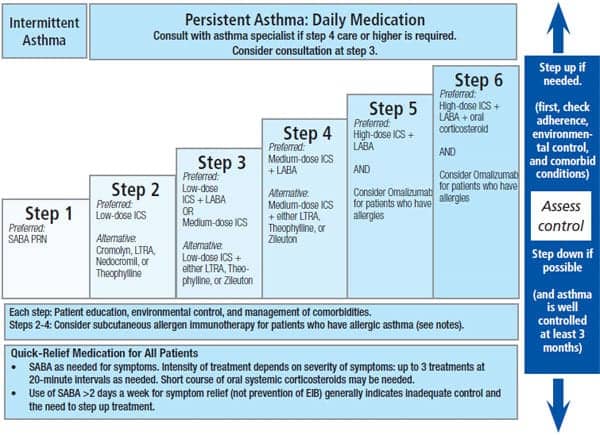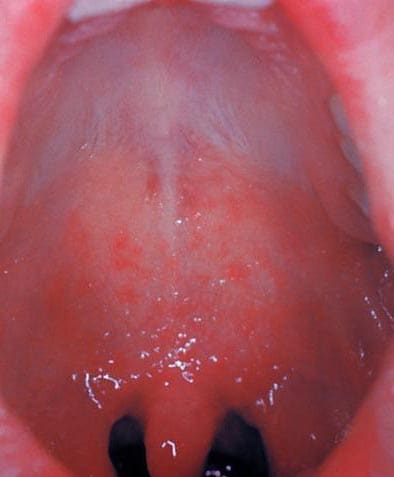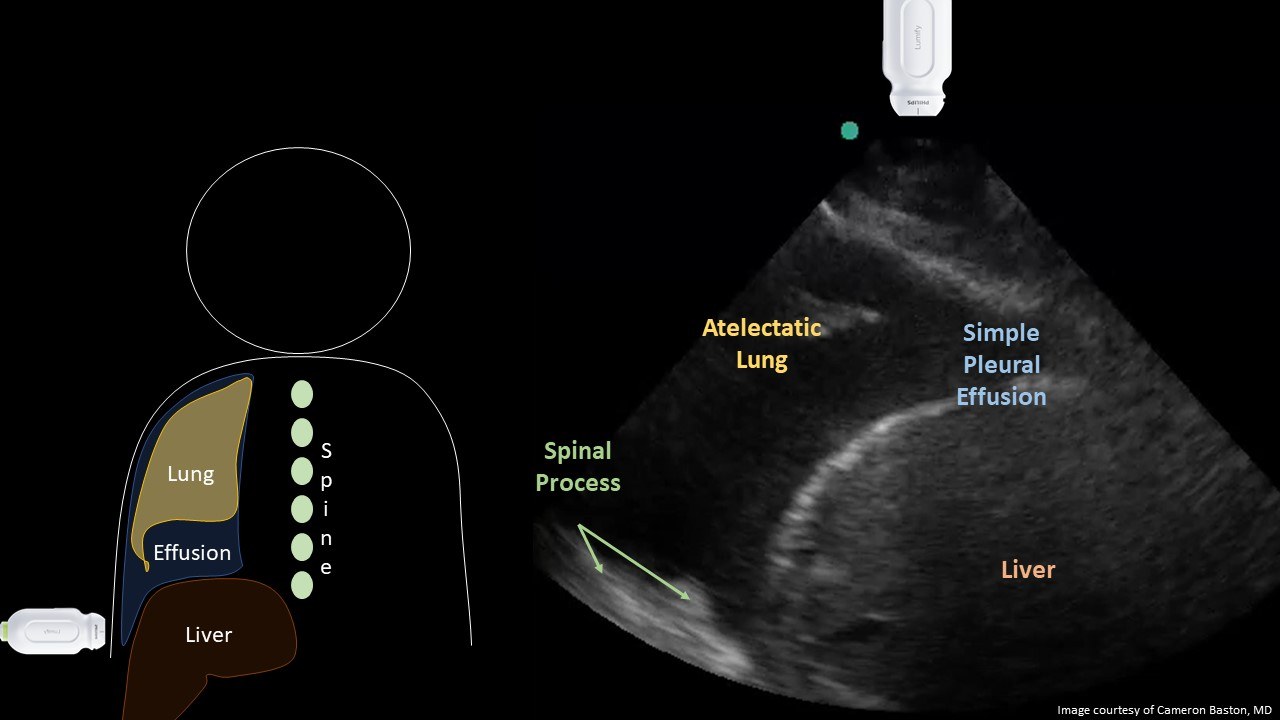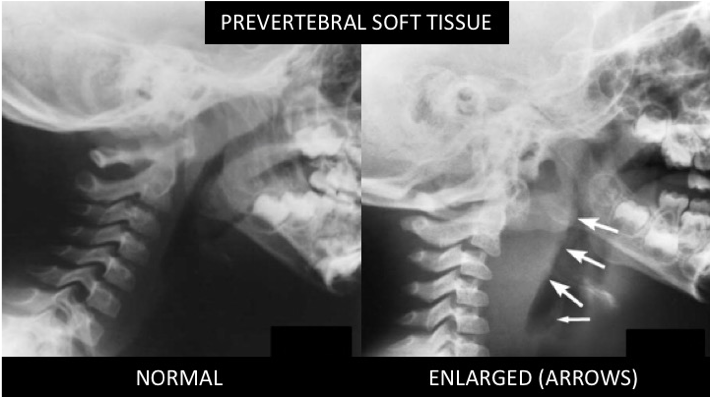& Diagnosis
Most cases of croup occur in the late fall or early winter, which corresponds with the seasonality of this respiratory virus that most commonly causes croup.
What is parainfluenza virus (specifically type 1)?
Best initial study to evaluate for a foreign body ingestion (i.e., most cost-effective, high value)
What is a chest x-ray (specifically AP/Portable)?
Next best step in management of this patient who ingested a button battery.

What is emergent endoscopic removal?
As an interesting learning point, batteries and coins can appear different on radiographs as below.
Name three modifiable triggers for asthma that you could counsel a family on.
- Smoke, especially tobacco
- Air quality
- Pollen
- Pet dander
- Mold
- Dust mites
- Strong odors
- Certain foods or medications
4 year old with atopic dermatitis and asthma is brought in from school to the ED in respiratory distress with widespread rash and vomiting/diarrhea/abdominal pain. Lung sounds are extremely tight/diminished though perhaps a wheeze is present. Besides asthma, name another diagnosis to keep on your differential.
What is anaphylaxis?
Most common reason for hospitalization in the first 12 months after birth (hint: what is the diagnosis)
What is bronchiolitis?
What is bronchiolitis?
Next best step in management of the infant below.
What is dexamethasone (0.3 mg/kg) and racemic epinephrine (2.25% solution, 0.5 mL in 3 mL of normal saline)?
The infant has stridor at rest and moderate to severe work of breathing.
The CDC recommends routine pneumococcal vaccination for all children younger than 5 years old. Name three conditions that necessitate additional vaccination in children due to increased risk for pneumococcal disease.
- Chronic heart disease
- Particularly cyanotic congenital heart disease and cardiac failure
- Chronic kidney disease, excluding maintenance dialysis or nephrotic syndrome
- Chronic lung disease
- Includes moderate persistent or severe persistent asthma
- Maintenance dialysis or nephrotic syndrome
- Cerebrospinal fluid leak
- Chronic liver disease
- Cochlear implant
- An immunocompromising condition
- Diabetes mellitus
- Congenital or acquired asplenia, or splenic dysfunction
- Congenital or acquired immunodeficiency
- Diseases or conditions treated with immunosuppressive drugs or radiation therapy
- HIV infection
- Sickle cell disease or other hemoglobinopathy
A 2 year old girl presents with fever, tachypnea, and is in significant discomfort. CBC remarkable for WBC 18 (PMN 75%), Hgb 6.8 (MCV 87), and platelets 600. Blood smear below. Chem 14 (aka CMP) is unremarkable aside from elevated LFTs (bilirubin, AST, ALT). CXR is obtained and is below. Name a likely diagnosis besides community acquired pneumonia.

What is acute chest syndrome (secondary to sickle cell)?
Interesting case reports:
The incidence of this common respiratory illness is highest between 6 months and 3 years of age, with its typical peak at 2 years old.
What is croup?
6 month old with inspiratory stridor that worsens when they are placed on their back in bed.
Laryngoscopy shown below. Name the probable diagnosis.

What is laryngomalacia?
6 year old patient with asthma (full history below) presents to clinic. They endorse daily cough and nighttime awakenings 1-2x/month. Next best step in management?
PMH: asthma, atopic dermatitis, food allergies
Meds: albuterol as needed (PRN)
ED visits: 3x in past year
Hospitalizations: 1x when 3 years old
PICU Stay for asthma: never
Start a low-dose ICS (e.g., fluticasone inhaler aka Flovent)


Chemoprophylaxis and vaccination are recommended to prevent H. influenzae disease type b (Hib). Name four illnesses caused by Hib.
The most common types of infections caused by typeable H. influenzae, including Hib, include:
- Pneumonia
- Bacteremia
- Meningitis
- Epiglottitis
- Septic arthritis
- Cellulitis
- Otitis media
- Purulent pericarditis
Less common infections include endocarditis and osteomyelitis.
Most likely diagnosis for a 2 year old girl is evaluated in the emergency room for rapid breathing that has lasted 2 days? She was seen at an outside hospital yesterday and diagnosed with a URI.
On physical examination, she has a temperature of 37.1°C, a heart rate of 135 beats/min, a blood pressure of 85/58 mm Hg, a respiratory rate of 45 breaths/min, and an oxygen saturation of 99% in room air. Her weight is 10.2 kg, which is 2.3 kg less than at a health supervision visit 1 month ago. She appears tired and is taking rapid, deep breaths. Her mucous membranes appear dry. The remainder of her physical examination findings are unremarkable.
Diabetic ketoacidosis
This life-threatening condition is defined by elevated blood glucose (>200 mg/dL [11.10 mmol/L]), ketosis, and metabolic acidosis (serum bicarbonate <15 mEq/L [15 mmol/L] or venous pH <7.3) with a widened anion gap.
Asthma can be diagnosed at any age, but the majority of children (~80%) have symptoms during what general age range?
What is the first six years of life?
A vaccinated 9 month old presents to clinic with fever, rhinorrhea, and cough. On oral exam, you visualize the below findings. What is the most likely diagnosis?

What is measles?
An ex-29 week neonate is transferred to the NICU due to difficulty breathing shortly after delivery. CXR is below. Besides supplemental oxygen and intubation, what is a potential treatment for this condition?

What is surfactant?
(For respiratory distress syndrome of the newborn)
The CDC supports providing post-exposure prophylaxis (PEP) within 21 days of exposure to an infectious pertussis case. Name two categories of people that pertussis PEP is recommended for.
- Household contacts of a pertussis case
- People at high risk of developing severe pertussis infection (infants under 12 months old, people with pre-existing health conditions like asthma or immunocompromised status)
- Those who will have contact with people at high risk of developing severe pertussis infection (pregnant people, pediatric and OBGYN healthcare workers)
Child previously diagnosed with croup due to mild stridor with activity now returns to the ED with high fever, barky cough, hoarse voice, and is toxic-appearing.
Imaging is obtained as below. Name the likely diagnosis.

What is bacterial tracheitis?
The "candle dripping sign" describes the irregular tracheal margins of bacterial/exudative tracheitis. Lateral neck x-ray may show a "steeple sign" similar to that of croup.
Name two risk factors for fatal asthma.
Any of the below are correct:
1. one or more life-threatening exacerbations of asthma
2. severe asthma requiring chronic oral corticosteroids
3. poor control of daily asthma symptoms requiring frequent short-acting beta2 agonist medication
4. abnormal forced expiratory volume in 1 second (FEV1)
5. frequent ED visits
6. low socioeconomic status
7. family dysfunction
8. patient psychological problems
Strunk RC. The fatality-prone asthmatic child and adolescent. Immunol Allergy Clin North Am. 1998;18:85–97
8 year old presents with >1 week of fever, cough, and abdominal pain. On physical exam, the left lower lobe has diminished breath sounds. There is dullness to percussion.
Chest x-ray is obtained as below. What is the next best step in work-up?

What is ultrasound (of the pleural space)? (due to concern for parapneumonic effusion)

Next best step in management for a 1 year old patient who presents with acute paroxysmal coughing spells, prolonged cough, and apneic episodes.
What are macrolides?
Erythromycin, clarithromycin, and azithromycin are preferred for the treatment of pertussis. Azithromycin is the drug of choice for treatment or prophylaxis of pertussis in very young infants.
Name three medications that can be given for RSV prevention.
1. Abrysvo: RSV vaccine for pregnant women
2. Beyfortus: Monoclonal antibody directly administered to infant called nirsevimab
3. Palivizumab (Synagis): Monoclonal antibody used to prevent serious RSV infections in high-risk infants and young children, particularly those born prematurely or with certain medical conditions
Most likely diagnosis for an unvaccinated 3 year old with fever, stridor, and nuchal rigidity. Imaging below.

What is retropharyngeal abscess?

Note: While both RPAs and meningitis can present with fever and neck stiffness, limited neck extension is a stronger indicator of RPA, while limited neck flexion is more common in meningitis. Additional clues for RPA include a bulging pharynx, respiratory distress, and less lethargy compared to meningitis.